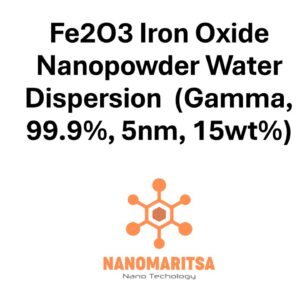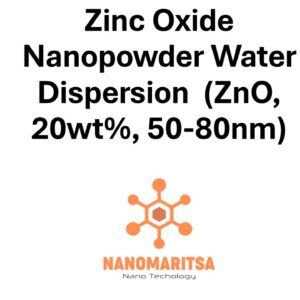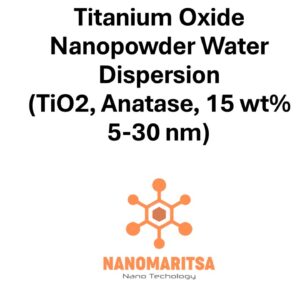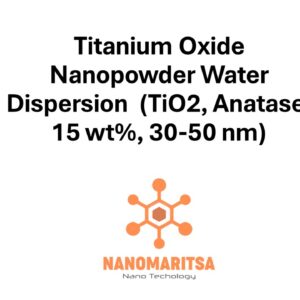Calcium Carbonate Nanopowder Water Dispersion (CaCO₃, 99.9%, 50 nm, 40 wt%) is a water-based dispersion containing Calcium Carbonate (CaCO₃) nanoparticles with an average particle size of 50 nm and a concentration of 40% by weight. Calcium Carbonate is a widely used material with many applications in various industries due to its non-toxic, cost-effective, and versatile nature. Below are the detailed specifications and uses of this product:
1. Composition and Properties:
- Material: The dispersion contains Calcium Carbonate (CaCO₃), a naturally occurring mineral that is used in a variety of applications, including as a filler in plastics, paints, and coatings, as well as in pharmaceuticals and food.
- Purity: This dispersion is composed of 99.9% pure Calcium Carbonate, ensuring minimal impurities and reliable performance in sensitive applications.
- Particle Size: The nanoparticles have an average size of 50 nm, providing a high surface area that enhances the material’s reactivity and dispersion properties in various applications.
- Concentration: The dispersion contains 40% Calcium Carbonate by weight, with the remaining 60% being water, which allows for easy handling, mixing, and application in different formulations.
2. Key Features:
- High Purity: The product is 99.9% pure CaCO₃, ensuring consistent and high-quality performance in various applications.
- Nanoparticle Size: With a 50 nm particle size, the dispersion provides a fine, uniform distribution of nanoparticles, which is ideal for enhancing surface area and improving performance in many applications.
- Water-Based Dispersion: The product is water-based, making it easier and safer to handle compared to solvent-based dispersions. It is more environmentally friendly and allows for better dispersion and uniformity in formulations.
- Concentration: The 40 wt% concentration of CaCO₃ ensures a high loading of the active material, making it suitable for high-performance applications that require significant amounts of nanoparticles.
3. Applications:
- Paints and Coatings: Calcium Carbonate is widely used as a filler in paints and coatings. The nanoparticles improve the opacity, brightness, and durability of coatings, while also acting as a cost-effective filler material.
- Plastics and Polymers: In the plastic industry, CaCO₃ nanoparticles are added to polymer matrices to improve mechanical properties like stiffness and strength. It also enhances the processability and reduces production costs.
- Pharmaceuticals: Calcium Carbonate is used as a pharmaceutical excipient, particularly as a binder, disintegrant, and filler in tablet formulations. It is also used as an antacid and calcium supplement.
- Food and Beverages: It is commonly used as a food additive (E170), where it serves as a coloring agent, anti-caking agent, and calcium supplement.
- Water Treatment: CaCO₃ nanoparticles are used in water treatment to adjust the pH levels and remove impurities, such as heavy metals and other contaminants.
- Cosmetics: Calcium Carbonate is used in cosmetics and personal care products as a filler, abrasive, or thickener in products like toothpaste, powders, and creams.
- Ceramics: CaCO₃ is used as a fluxing agent in ceramics to lower the melting point and improve the overall properties of the final product.
4. Advantages:
- High Surface Area: The 50 nm particle size provides a high surface area, which can improve the material’s performance in terms of reactivity, dispersion stability, and mechanical properties in various applications.
- Non-Toxic and Biocompatible: Calcium Carbonate is non-toxic and widely regarded as safe for use in food, pharmaceuticals, and cosmetics, making it a popular choice for industries requiring safe materials.
- Water-Based: The water-based nature of this dispersion makes it safer to handle and process, with reduced environmental and health risks compared to solvent-based formulations.
- Cost-Effective: Calcium Carbonate is an abundant and low-cost material, which makes it an attractive filler and additive in various industries, reducing overall production costs.
- Stable Dispersion: The water-based dispersion allows for uniform distribution of nanoparticles, reducing the risk of agglomeration and ensuring consistent performance in applications.
5. Handling and Storage:
- Storage: Store the dispersion in a cool, dry place, away from direct sunlight. Ensure the container is tightly sealed to prevent evaporation of water and maintain the material’s stability.
- Handling: Personal protective equipment (PPE) such as gloves, goggles, and a lab coat should be used when handling the dispersion to avoid skin or eye contact with the nanoparticles.
- Safety: While Calcium Carbonate is generally considered safe, it is important to follow safety protocols when working with nanopowders, especially to avoid inhalation or prolonged exposure.
Summary:
Calcium Carbonate Nanopowder Water Dispersion (CaCO₃, 99.9%, 50 nm, 40 wt%) is a high-quality, water-based dispersion containing Calcium Carbonate nanoparticles with an 80 nm particle size and a 40 wt% concentration. It is ideal for applications in industries such as paints, plastics, pharmaceuticals, food, water treatment, and cosmetics, offering high surface area, non-toxicity, and cost-effectiveness. The water-based formulation makes it safer to handle, while the high purity and nanoparticle size improve the material’s dispersion stability, reactivity, and performance in various applications.






